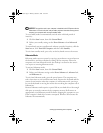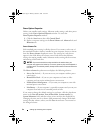
48 Setting Up and Using Your Computer
If a drive failure occurs, subsequent read and write operations are directed to the
surviving drive. A replacement drive can then be rebuilt using the data from the
surviving drive. Also, because data is duplicated on both drives, two 120-GB RAID
level 1 drives collectively have a maximum of 120-GB on which to store data.
NOTE: In a RAID level 1 configuration, the size of the configuration is equal to the
size of the smallest drive in the configuration.
Configuring Your Hard Drives for RAID
Your computer can be configured for RAID even if you did not select a RAID
configuration when you purchased your computer. You must have at least two
hard drives installed in your computer to set up a RAID configuration. For
instructions on how to install a hard drive, see "Hard Drives" on page 140.
You can use one of two methods to configure RAID hard drive volumes.
One method uses the Intel
®
Option ROM utility, and is performed before
you install the operating system onto the hard drive. The second method uses
the Intel Matrix Storage Manager or Intel Storage Utility, and this method is
performed after you have installed the operating system and the Intel Storage
Utility. Both methods require that you set your computer to RAID-enabled
mode before starting any of the RAID configuration procedures in this
document. Both methods require that you set your computer to
RAID-enabled mode before you begin.
hard drive 1
segment 1
segment 2
segment 3
hard drive 2
segment 4
segment 5
segment 6
segment 1 duplicated
segment 2 duplicated
segment 3 duplicated
segment 4 duplicated
segment 5 duplicated
segment 6 duplicated
serial ATA RAID
configured for
RAID level 1
book.book Page 48 Monday, October 6, 2008 11:28 AM


















